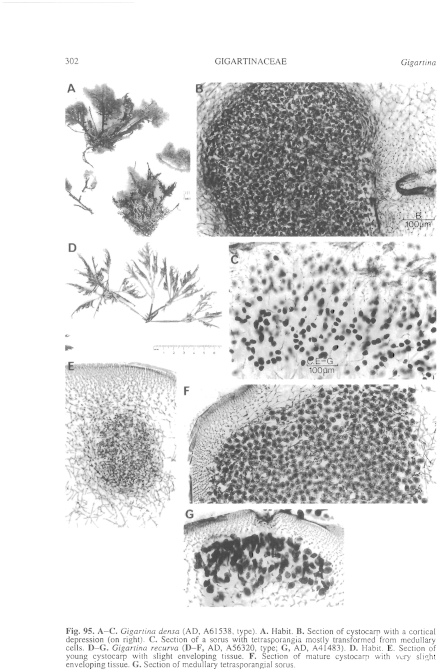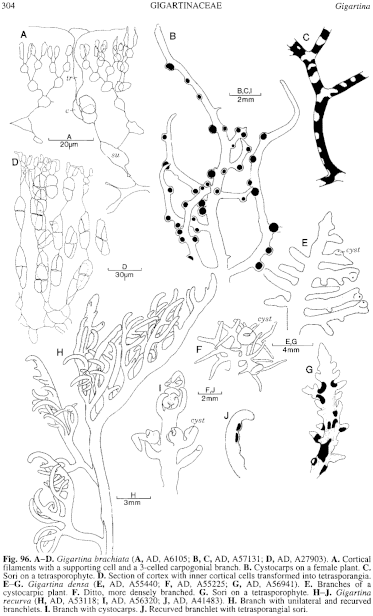|
|
|
|
|
|||||||||||
|
Electronic Flora of South Australia Species Fact Sheet
Phylum Rhodophyta – Class Florideophyceae – Order Gigartinales – Family Gigartinaceae
Synonym
G. ancistroclada sensu J. Agardh 1876: 198; 1899: 21. [NON G. ancistroclada Montagne 1842: 6; 1845: 121, pl. 7 fig. 4.]
Thallus (Figs 95D, 96H) dark brown-purple, fading to yellow-brown, erect and moderately rigid, 4–10 cm high, cartilaginous, with clumped axes densely and mainly unilaterally branched above, bare below and sometimes proliferous. Fronds (Fig. 96H) with percurrent, linear, compressed axes 1–2 (–3) mm broad, often di- to polychotomous in the upper part (following damage?), with the upper laterals compressed and slightly channelled on the adaxial surface, 0.5–1.5 (–2.5) mm broad, with ramuli borne from near their margins and turned towards the concave side; ramuli 0.5–1 mm broad, 2–4 mm long, curved. Holdfast discoid, 2–5 mm across bearing few to several axes; epilithic. Structure of a dense cortex of slender, anticlinal, subdichotomous filaments, outer cells 1–2 µm in diameter and L/D 1–2, and a medulla of slender anastomosing filaments.
Reproduction: Sexual thalli dioecious. Carpogonial branches 3-celled, situated on scattered inner cortical (supporting) cells near tips of ramuli. Cystocarps (Fig. 96I) in branchlets on their concave surfaces (within the channel), naked or with an involucre of up to 4 ramuli, 0.5–1 mm across with the cortex depressed outside the cystocarp; enveloping tissue (Fig. 95E) lax and slight, with transverse filaments extending from the gonimoblast, carposporophyte (Fig. 95E, F) reticulate, with scattered larger cells with thickened pit-connections, bearing clusters of ovoid carposporangia 10–25 µm in diameter. Spermatangial sort inconspicuous, on upper branchlets, with outer cortical cells cutting off spermatangia each producing a single ovoid spermatium about 1 µm in diameter.
Tetrasporangial soli (Fig. 96J) maculate, circular to elongate, situated beneath the apex of the curved branchlets on their concave side; tetrasporangia (Fig. 95G) derived from rows of inner cortical and outer medullary cells (with some formed laterally) but lying in the outer medulla, ovoid to elongate-ovoid, 15–25 µm in diameter and 30–55 µm long, cruciately divided.
Type from Bicheno, Tas., lower eulittoral (Womersley, 4.xi.1982); holotype in AD, A56320 - Isotypes in "Marine Algae of southern Australia" No. 356.
Selected specimens: Musselroe Bay, Tas., on rocks at low tide (Perrin 724, Mar. 1937; AD, A49697). The Gardens, 20 km N of St Helens, Tas., mid eulittoral (Womersley, 21.x.1986; AD, A57460). Safety Cove, Port Arthur, Tas., at low tide (Edyvane, 16.ii.1986; AD, A60756). Ninepin Point, D'Entrecasteaux Ch., Tas., at low tide (Edyvane, 15.iii.1982; AD, A53118). Satellite I., D'Entrecasteaux Ch., Tas., 0–2 m deep (Shepherd, 18.ii.1972; AD, A41483 -"Marine Algae of southern Australia" No. 356a). Gordon, Tas., on jetty piles, lower eulittoral (Skinner, 28.ii.1978; AD, A49193). Catamaran, Recherche Bay, Tas., upper sublittoral (Wollaston & Mitchell, 27.ii.1964; AD, A27741).
Distribution: East coast of Tasmania, usually in the lower eulittoral on moderate to rough-water coasts.
Taxonomic notes: This species has been known as G. ancistroclada Montagne (1842, p. 6; 1845, p. 121, pl. 7 fig. 4), the type of which came from Akaroa, New Zealand (see Chapman 1979, p. 388). This type, in PC, is distinct from the Tasmanian plant in having largely pinnate branching, without the unilateral branchlets of the Tasmanian species. Parsons (pers. comm.) considers G. ancistroclada is probably a form of the New Zealand G. decipiens (Hooker & Harvey) Harvey. Specimens from "Sidney", in MEL, 652025, ex Herb. Sonder, are clearly not from this locality in N.S.W.
G. recurva is a distinctive species, known only from eastern Tasmania where it is common in the lower eulittoral on steeply sloping rock. It is characterised by its habit, with clumped axes which are largely unilaterally branched above with curved to recurved ramuli. The tetrasporangia are transformed from anticlinal rows of inner cortical and outer medullary cells, with some lateral divisions. The mature sorus lies in the outer medulla. G. recurva has very little enveloping tissue, but the carposporophyte is circumscribed in contrast to that of Chondrus crispus where the gonimoblast filaments and carposporangia extend irregularly into the medulla (Fredericq et al. 1992, p. 557, fig. 45).
References:
AGARDH, J.G. (1876). Species Genera et Ordines Algarum. Vol. 3, Part 1 - Epicrisis systematis Floridearum, pp. i-vii, 1–724. (Weigel: Leipzig.)
AGARDH, J.G. (1899). Analecta Algologica. Cont. V. Acta Univ. lund. 35, 1–160, Plates 1–3.
CHAPMAN, V.J. (1979). The marine algae of New Zealand. Part DI Rhodophyceae. Issue 4: Gigartinales. (Cramer: Germany.)
FREDERICQ, S., BRODIE, J. & HOMMERSAND, M.H. (1992). Developmental morphology of Chondrus crispus (Gigartinaceae, Rhodophyta). Phycologia 31, 542–563.
MONTAGNE, C. (1842). Prodromus Generum Specierumque Phycearum Novarum in Itinere ad Polum Antarcticum. (Paris.)
MONTAGNE, C. (1845). Voyage au Pôle Sud et dans l'Océanie sur les Corvettes l'Astrolabe et la Mee. Botanique, T I. Plantes cellulaires. (Plates 1–20 dated 1852.)
The Marine Benthic Flora of Southern Australia Part IIIA complete list of references.
Publication:
Womersley, H.B.S. (14 January, 1994)
The Marine Benthic Flora of Southern Australia
Rhodophyta. Part IIIA, Bangiophyceae and Florideophyceae (to Gigartinales)
Reproduced with permission from The Marine Benthic Flora of Southern Australia Part IIIA 1994, by H.B.S. Womersley. Australian Biological Resources Study, Canberra. Copyright Commonwealth of Australia.
Illustrations in Womersley Part IIIA, 1994: FIGS 95 D–G, 96 H–J.

Figure 95 enlarge
Fig. 95. A–C. Gigartina densa (AD, A61538, type). A. Habit. B. Section of cystocarp with a cortical depression (on right). C. Section of a sorus with tetrasporangia mostly transformed from medullary cells. D–G. Gigartina recurva (D–F, AD, A56320, type; G, AD, A41483). D. Habit. E. Section of young cystocarp with slight enveloping tissue. F. Section of mature cystocarp with very slight enveloping tissue. G. Section of medullary tetrasporangial sorus.

Figure 96 enlarge
Fig. 96. A–D. Gigartina brachiata (A, AD, A6105; B, C, AD, A57131; D, AD, A27903). A. Cortical filaments with a supporting cell and a 3-celled carpogonial branch. B. Cystocarps on a female plant. C. Sori on a tetrasporophyte. D. Section of cortex with inner cortical cells transformed into tetrasporangia. E–G. Gigartina densa (E, AD, A55440; F, AD, A55225; G, AD, A56941). E. Branches of a cystocarpic plant. F. Ditto, more densely branched. G. Sori on a tetrasporophyte. H–J. Gigartina recurva (H, AD, A53118; I, AD, A56320; J, AD, A41483). H. Branch with unilateral and recurved branchlets. I. Branch with cystocarps. J. Recurved branchlet with tetrasporangial sori.

|
Email Contact: State Herbarium of South Australia |

|